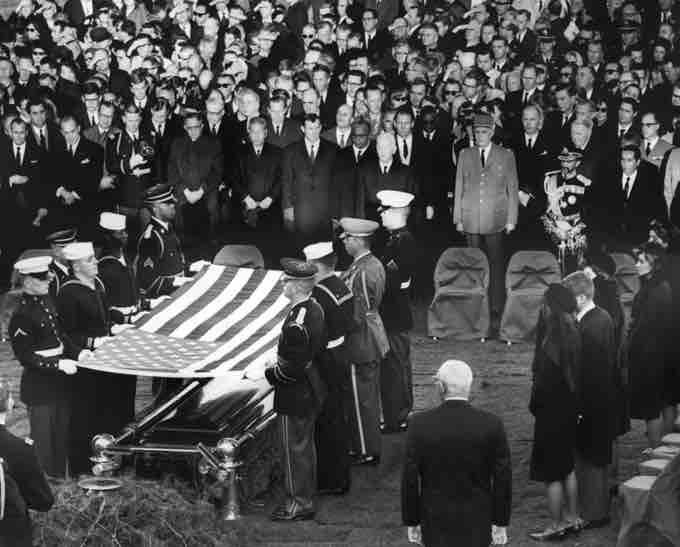John F. Kennedy was assassinated at 12:30 p.m. on Friday, November 22, 1963, in Dealey Plaza in Dallas, Texas. He was fatally shot while traveling with his wife Jacqueline, Texas governor John Connally, and Governor Connally's wife Nellie, in a presidential motorcade.
Route to Dealey Plaza
Although his stance on civil rights had won him support in the African American community and his steely performance during the Cuban Missile Crisis had led his overall popularity to surge, Kennedy understood that he had to solidify his base in the South to secure his reelection. On November 21, 1963, he accompanied Vice President Lyndon Johnson to Texas to rally his supporters.
President Kennedy's motorcade route through Dallas on November 22 was planned to give him maximal exposure to Dallas crowds before his arrival at a luncheon with civic and business leaders in the city. The actual route through Dallas was chosen to be a meandering 10 miles, which could be driven slowly in the allotted time. The planned route was widely reported in Dallas newspapers several days before the event for the benefit of people who wished to view the motorcade.
At about 11:40am, the presidential motorcade left for the trip through Dallas. By the time the motorcade reached Dealey Plaza, Kennedy was only 5 minutes away from the planned destination. At 12:30 p.m., as Kennedy's uncovered limousine entered Dealey Plaza, a reported three shots were fired at Kennedy. Seriously injured, Kennedy was rushed to Parkland Hospital; at 1:00 p.m., the President was pronounced dead.
Vice-President Johnson (who had been riding two cars behind Kennedy in the motorcade through Dallas and was not injured) became President of the United States upon Kennedy's death. At 2:38 p.m., Johnson took the oath of office on board Air Force One just before it departed.
Lee Harvey Oswald
The gunfire that killed Kennedy appeared to come from the upper stories of the Texas School Book Depository building; later that day, Lee Harvey Oswald, an employee at the depository and a trained sniper, was arrested. He was charged with the murders of President Kennedy and Dallas police officer J.D. Tippit later that night. Oswald denied shooting anyone and claimed he was a being framed because he had lived in the Soviet Union. Oswald's case never came to trial because he was shot and killed by Dallas nightclub owner Jack Ruby two days later while Oswald was being escorted to a car for transfer from Dallas Police Headquarters to the Dallas County Jail. Arrested immediately after the shooting, Ruby later said he had been distraught over the Kennedy assassination and sought to avenge the president's death.
Kennedy's Funeral
The news shocked the nation. Men and women wept openly. People gathered in department stores to watch the television coverage, while others prayed. Traffic in some areas came to a halt as the news spread from car to car. Schools across the U.S. dismissed their students early.The state funeral took place in Washington, D.C. during the three days that followed the assassination. The body of President Kennedy was brought back to Washington, D.C. and placed in the East Room of the White House for 24 hours. On the Sunday after the assassination, his coffin was carried on a horse-drawn caisson to the U.S. Capitol to lie in state. Throughout the day and night, hundreds of thousands of people lined up to view the guarded casket. Representatives from over 90 countries attended the state funeral on Monday, November 25. After the Requiem Mass at St. Matthew's Cathedral, the late president was laid to rest at Arlington National Cemetery in Virginia.

JFK's Funeral
An honor guard folds the flag of the United States at Arlington National Cemetery in preparation for flag presentation to Jacqueline Kennedy on November 25, 1963.
Investigations and Conspiracies
President Johnson created the Warren Commission to investigate the assassination, which concluded that Oswald was the lone assassin. The ten-month investigation by the Warren Commission concluded that the President was assassinated by Lee Harvey Oswald acting alone, and that Jack Ruby acted alone when he killed Oswald before he could stand trial. These conclusions were initially supported by the American public; however, polls conducted from 1966 to 2004 found that as many as 80 percent of Americans have suspected that there was a plot or cover-up. The assassination is still the subject of widespread debate and has spawned numerous conspiracy theories and alternative scenarios.